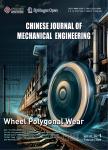Integrated Modelling of Microstructure Evolution and Mechanical Properties Prediction for Q&P Hot Stamping Process of Ultra‑High Strength Steel
Integrated Modelling of Microstructure Evolution and Mechanical Properties Prediction for Q&P Hot Stamping Process of Ultra-High Strength Steel作者机构:Institute of Forming Technology&EquipmentSchool of Materials Science and EngineeringShanghai Jiao Tong UniversityShanghai 200030China National Engineering Research Center of Die and Mold CADShanghai Jiao Tong UniversityShanghai 200030China.
出 版 物:《Chinese Journal of Mechanical Engineering》 (中国机械工程学报(英文版))
年 卷 期:2020年第33卷第3期
页 面:160-173页
核心收录:
学科分类:080503[工学-材料加工工程] 08[工学] 0805[工学-材料科学与工程(可授工学、理学学位)] 0802[工学-机械工程] 080201[工学-机械制造及其自动化]
基 金:Supported by National Natural Science Foundation of China (Grant Nos. 51775336,U1564203) Program of Shanghai Academic Research Leadership (Grant No. 19XD1401900)
主 题:Q&P hot stamping Phase transformation model Microstructure evolution Product properties prediction
摘 要:High strength steel products with good ductility can be produced via Q&P hot stamping process,while the phase transformation of the process is more complicated than common hot stamping since two-step quenching and one-step carbon partitioning processes are *** this study,an integrated model of microstructure evolution relating to Q&P hot stamping was presented with a persuasively predicted results of mechanical *** transformation of diffusional phase and non-diffusional phase,including original austenite grain size individually,were considered,as well as the carbon partitioning process which affects the secondary martensite transformation temperature and the subsequent phase ***,the mechanical properties including hardness,strength,and elongation were calculated through a series of theoretical and empirical models in accordance with phase ***,a modified elongation prediction model was generated ultimately with higher accuracy than the existed Mileiko’s *** the end,the unified model was applied to simulate the Q&P hot stamping process of a U-cup part based on the finite element software LS-DYNA,where the calculated outputs were coincident with the measured consequences.



